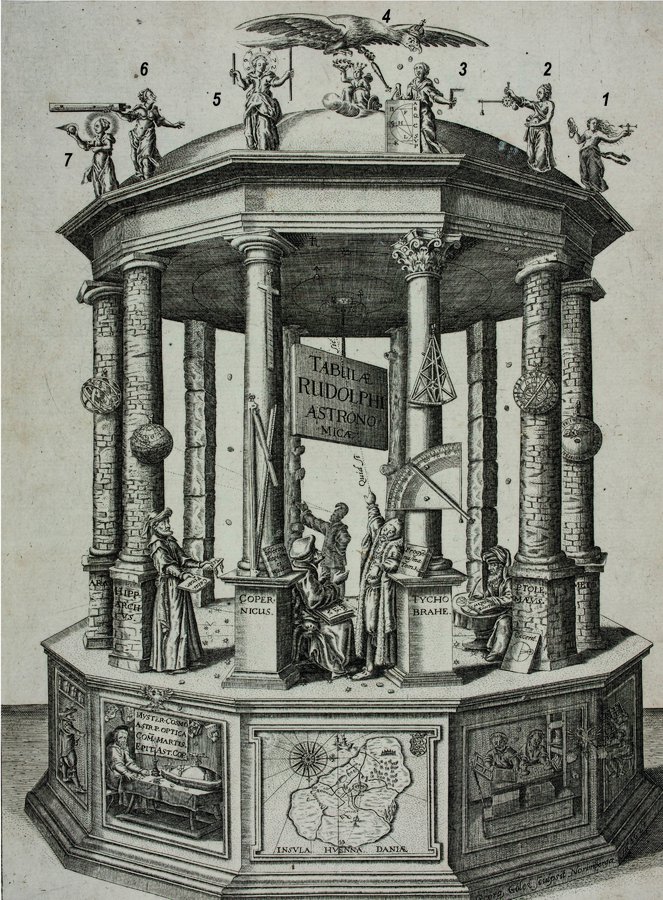Rudolphine Tables
Rudolphine Tables (Lat: Tabulae Rudolphinae) are a set of tables used for predicting the positions of the planets. In 1600, Kaiser Rudolf II commissioned Tycho Brahe and Johannes Kepler to calculate a more accurate set of planetary tables. Following Brahe's death in 1601, Kepler continued alone and completed the tables in 1627.
The Pillared Cupola bears the symbols of Kepler's work. The imperial eagle on the roof symbolises Kepler's desire that the Kaiser ought always to pay for his work. Urania – the goddess of astronomy is mounted at the centre of the roof . Kepler's scientific works are represented by twelve nymphs or goddesses.
The plinth provides an insight into the preparation and creation of the Rudolphine Tables.
The panel on the far left is dedicated to Tycho Brahe and shows his books in a row. The central panel bears an image of Ven Island, which was the location of Tycho's observatory. One can recognise Uraniborg, the main palace and the observatory, village houses, fish ponds and a small forest.
The two panels to the far right are dedicated to book printing. One can the typesetter sitting at his letter tray, flanked by two busy printers. The coat of arms and eagle indicate that the printer's workshop is situated in Ulm. To the left of the relief showing Ven Island one can see Johannes Kepler sitting in his candlelit study. Above him are a coat of arms and the titles of those books, which one could consider to represent the route that culminates in the Rudolphine Tables.
The column structure symbolizes the history of astronomy from the first astrologers to Tycho Brahe. There are ten columns in total with the names of astronomers and images of their instruments (from the left to the right):
The column of Aratos from Soloi (first column from the left): He was a poet who lived in the third century before Christ and became famous with his poem „PHAENOMENA“, a description of the sky.
The column of Hipparchos (second column from the left): He lived in the second century before Christ and is considered as the greatest astronomer of ancient times. The planet theory with circles and epicycles is attributed to him. Furthermore, he developed a star catalogue with precise star positions and star brightness. The sealed testament he holds in his hand symbolizes the star catalogue as legacy for following astronomers.
The column of Nicolaus Copernicus follows: The lower instrument installed at the column is the triquetum designed by Copernicus. Copernicus sits opposite of Tycho Brahe and it looks like they are discussing. Copernicus holds the fifth volume of his works in his hand in which the movements of the five planets are described.
The person in old traditional costumes in the background targets two stars with stretched out arm and index finger. It symbolizes the first instruments of astronomical research: the human hand and the human eye.
Tycho Brahe is honoured with the most beautiful column. His quadrant and sextant, both developed by him, are attached to the column. Furthermore, the book „Astronomiae instauratae progymnasmata“, published by Kepler in 1602, leans on his column. It presents the results of his observations.
The column of Ptolemy (second column from the right): The board leaning on the column reminds of his greatest achievement - the moon theory.
The column of Meton (on the right): He lived in the fifth century and, as far as known, was the first one who determined the length of the solar year. A board with a nineteen times divided ring is attached to this column. It symbolizes the Metonic cycle.
Legend:
1) Magnetica, the Doctrine of Magnetism
2) Stathmica, the Art of Measuring
3) Doctrina Triangulorum, the Triangle Doctrine with Square and Circle
4) Imperial Eagle; below: Uania - the Goddess of Astronomy
5) Logarithmica, the Goddess of Logarithms
6) Optica, the Optical Doctrine
7) Physica Lucidi et Pellucidi, Lucius & Umbram, the Theory of Light

